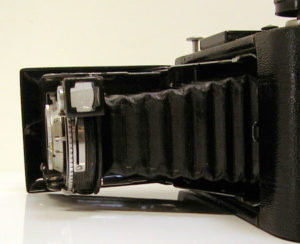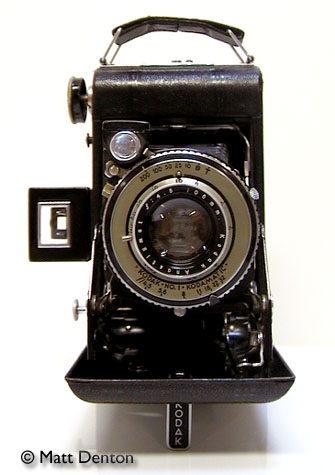- Produced 1939-49 Eastman Kodak Co, Rochester, NY USA
- Film type 620
- Picture size 6cm x 9cm
- Weight 1lb, 13.1oz (825g)
- Lens Kodak Anastigmat 105mm f4.5 (4.5-32)
- Focal range 3.5′ to infinity
- Filter size accepts Series VI with the 1 1/4″ (31.5mm) slip-on adapter
- Shutter Kodamatic
- Shutter speeds T, B, 1/10-200
- Viewfinder angled mirror finder plus popup viewfinder w/ parallax dial
- Exposure meter none
Overview
Sturdy compact folding camera, very similar in size and make, believe it or not, to the venerable Voigtlander Bessa. There was certainly plenty of cross-pollination between Kodak and German camera makers, especially after Kodak bought the Nagel Kamera Werk in Stuttgart (1934?) and began making Retinas. Not that I think the Vigilant is in the same class as either the Moskvas or Ikontas, mind you, but it seems to be up there as far as Kodak cameras are concerned. LIke the Agfa Plenax, the Vigilant was available in a 620 (Six-20) and 616 (Six-16) film models. The Vigilant Six-16 had a 125mm lens. 616 film is to 116 as 620 is to 120, and neither 616 or 116 is available any longer. (Of course, neither is 620!) The Vigilant Six-20s were available with different lenses (Kodak Anastigmat or Kodak Anaston) and shutters (Diamatic, Kodamatic, Flash Kodamatic, Flash Dakon). Lenses were either f4.5 or f6.3, shutters were either T-200 (Kodamatic) or T-100 (Dakon).
There was also a pair of Vigilant Juniors which were, shall we say, budget models, with simple DAK shutters (T, B, and ‘Instant’) and fixed-focus f12.5 Kodet lenses. The Junior models also lack a body release. Further note – I believe the successor to the Vigilant was the even more impressive (and more collectible) Kodak Monitor. It also had some lens/shutter variations (Anastigmat vs. Anaston, Flash Kodamatic vs. Kodamatic No. 1), and sported auto frame counting and double-exposure prevention. Other than that it appears to be nearly the same camera as the Vigilant.
Nice features on this camera: heavy construction, for one. It’s very sturdy. Sports a smooth body-mounted shutter release button like the better folders I’ve seen. These are strictly mechanical linkages that press the shutter-mounted release with a small lever so you don’t have to reach around in front. A single button unlocks the bellows for opening or closing, and it locks into place very decisively. Open, that is — the closing latch on mine isn’t catching. It’s awkward to bend the offending part, I’ll probably just shut it up with a rubber band for now. Angle finder and viewfinder, as usual the angle finder is so small it’s rather unhelpful, but the pop-up viewfinder sports a little dial that shifts the near window for approximate parallax compensation. It only has four settings, 4′, 6′, 25′, and infinity. Lastly, the camera has a nice strong shutter – the venerable Kodamatic seems not only strong but fairly accurate after all these years, and that without a cleaning.
Now for the questionable – I mentioned the iffy latch and the fact that the camera takes 620 film (requires respooling). A picky thing – you have to move the angle finder to the side in order to cock the shutter, it sits above the lever. Self-timer is very weak, probably just a weak spring and for me not worth investigation. Parallax adjustment on the finder, while a nice idea, is a little cheesy. And you can read about the bellows below in the repair section, apparently the Vigilants had comparatively poor-quality bellows, though it probably seemed a good idea at the time…. Now all that isn’t too much, overall this is a nice, well-constructed folder capable of years of hard work and good quality pictures. My warning is to pay attention to the model you’re looking at, because of the multiple variations of shutter and lens. 4.5 is better than 6.3, Kodamatic is better than Dakon and the Kodak Anastigmat is superior to the Anaston. Of course the uncoated Anastigmat (not the Special, which preceded the brilliant Anastar) is itself only a decent performer, better than the Hypar on the Plenax but not as good as coated triplets like the Zeiss Novar.
Repairs
Apart from the dust and the dirty glass, which cleaned right up with Windex, this camera was in good mechanical shape, but the bellows was deteriorated on top where the sun had apparently been shining on it for some years. Some research told me that the Kodak Vigilant bellows were of notoriously poor quality, comparatively, and that even the lowly Kodak Tourist had better bellows. I didn’t want to replace the bellows altogether if I didn’t have to. A little more research turned up a beautiful secret…see, the underlying fabric was intact so it was just a matter of replacing the coating with something flexible and light-tight. Options are Elmer’s glue mixed with lamp black, black acrylic paint, glued-on strips of shutter cloth, liquid neoprene (for repairing wetsuits), or black ‘Gutta resist’ by craft company Jacquard, pictured here with the undoctored bellows:

It’s a latex product that is essentially like a rubberized paint and is used in silk painting. Here’s some info. It’s available at craft stores (probably including online craft stores). They only had the large 8oz bottle (seriously, enough for me and all my friends) for $14US. It does come in a 4oz bottle, and maybe you can do better pricewise, but I was in a hurry. Anyway, it paints on and dries black and flexible, a couple of coats and the bellows looks like new and is light-tight again. Great stuff! One note – it stinks like crazy, it and Pliobond are the two most toxic fumes in my arsenal. Use in well-ventilated area with caution, probably good to use those little disposable aluminum solvent brushes you can get at the hardware store for pennies. NOTE – I only just used it, I’ve no idea about its permanence. I’ll keep you posted, though. Here’s what it looks like after the treatment:

Tips & Tricks
Respooling required, see Links below. Easy stuff, you just need two turntables and a microphone… I mean, two 620 spools and a changing bag. It’s a zone focus camera, so you’ll need to learn zone focusing and estimating exposure. And remember that 6×9 means only 8 frames on a 120 roll, and that if you don’t turn carefully and keep your eye on the red window you can skip right past one of those little digits and end up getting oh, five. Not that I’ve done that, of course. A few times.
Takes the same Series VI adapter as the Kodak 35 RF, not too surprising I guess since it’s the same lens (Anastigmat) and they were basically contemporary. What is really surprising is that I actually have two of the things. Before coatings, there were filters…
Related Links
- Some info on this and a few others at Ron Herron’s page
- Bellows repair info at Medium Format Home
